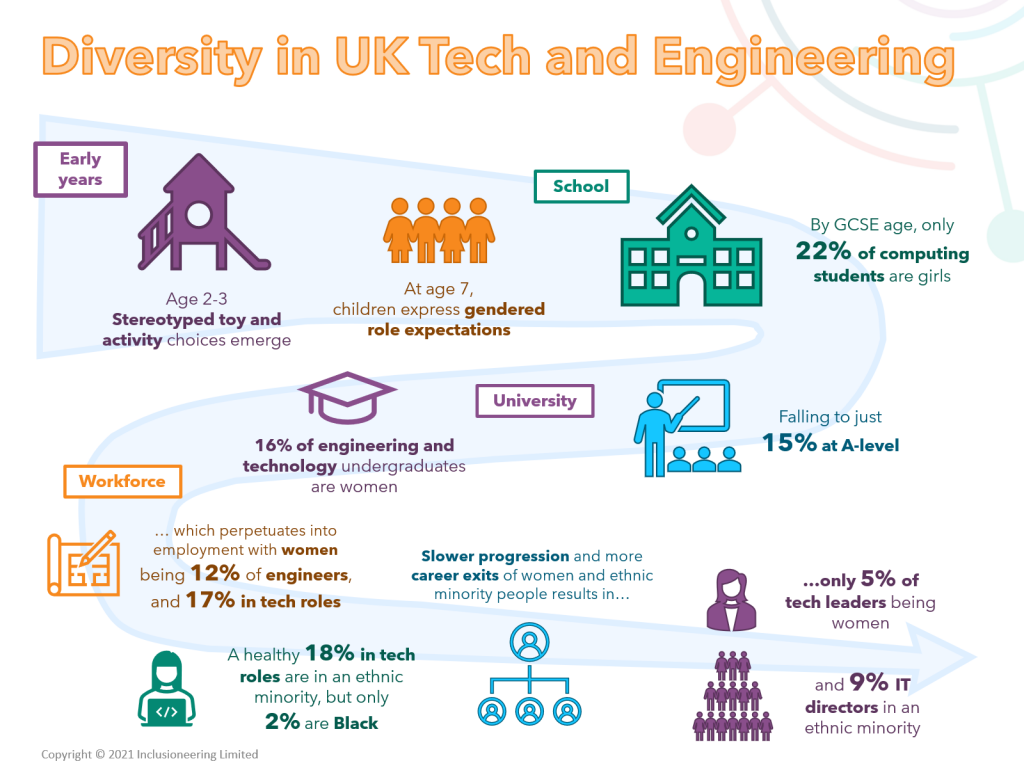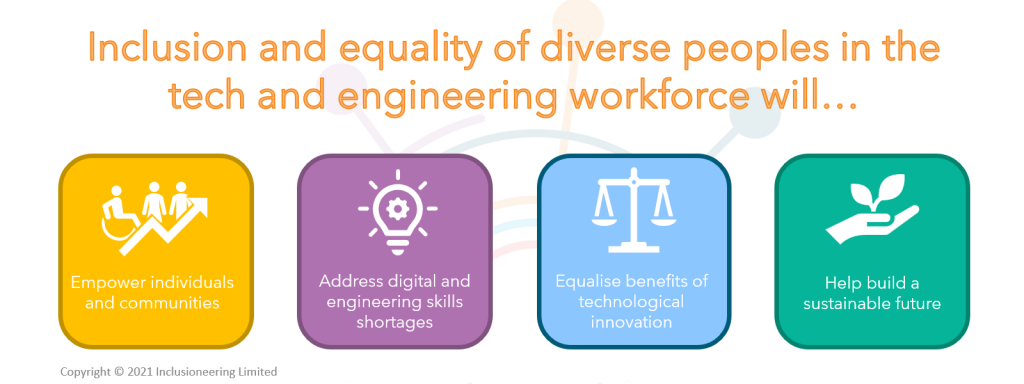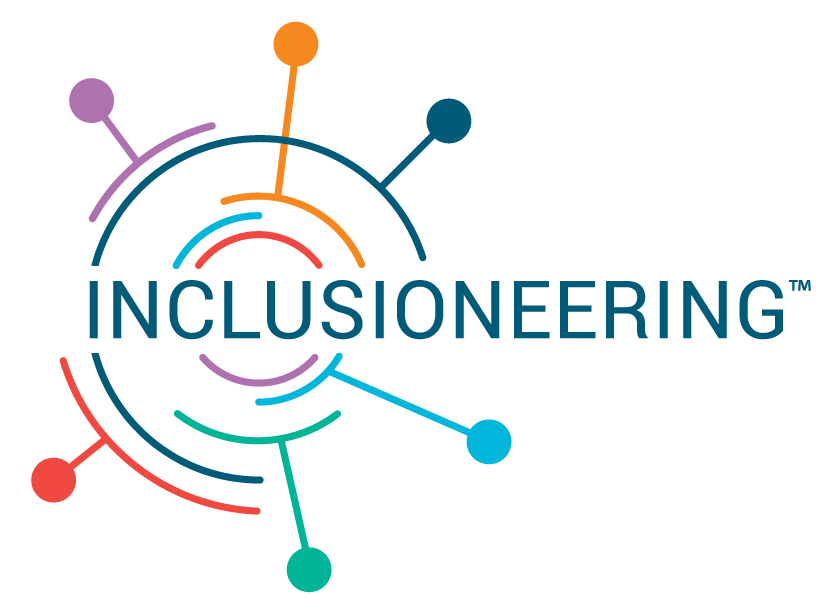Given the breadth of challenges and ubiquity of benefits of diversity and inclusion, why do we see tech and engineering industries often singled out for special attention? In this article, we unpack the unique challenges, and also opportunities, for these typically white, male-dominated industries.
Across industries, diversity and inclusion are increasingly recognised as business imperatives. The events of 2020 have brought sharp focus to this need, yet also amplified existing inequalities across society. Women, people from ethnic minority backgrounds, the LGBTQ+ community and people with disabilities have faced particular adverse impacts, wide-ranging across their health, personal safety, access to services, employment and financial security.
From this year of crisis, many organisations have risen to meet the needs of their workforce with flexibility and empathy. Spanning industries, a growing body of evidence has established that inclusion of diverse voices not only benefits employee wellbeing and engagement, but also boosts organisations’ innovation, productivity, resilience and profit. Simply put, it’s a classic win-win.
Why single out tech and engineering industries?
It is well reported that women, people from ethnic minorities and other marginalised groups face inequality at work, gaining lower status roles, more often in insecure employment, and impacted by pay gaps. Towards the senior levels of organisations, the “leaky pipeline” sees representation of women and ethnic minority groups plummet, with only 21% of C-suite roles in the USA held by women, and only 3% held by women of colour.
Yet in the male-dominated industries of technology and engineering, these workforce gaps are present not only in senior roles, but also at entry level.
Only 12% of engineering roles are held by women in the UK, and 17% of tech roles. The origin of these gaps can be traced right back through education, even to attitudes observed in young children. Stereotyped choices in play, and gendered expectations of parents’ careers and home-making roles, are seen as early as age 2. Evidence indicates that these differences are rooted in social constructs, with young children receiving social cues about what “people like them” can and should do – messages that persist into and throughout adulthood. These social expectations shape beliefs of who can succeed with engineering and technical challenges, and they differ not only by gender, but also ethnicity and other identity characteristics.

Why is diversity important for tech and engineering?
What does it matter if some sections of society are underrepresented in the tech and engineering workforces?
We examine four key opportunity areas – specific to these white, male-dominated industries – arising from greater inclusion and equality of diverse peoples.
1. Equal opportunities and economic empowerment
These industries demand problem solvers, creative and logical thinkers, collaboration. The work is skilled, and people with the relevant skills are in demand. Many roles are well paid, and there is opportunity to develop deep expertise and leadership skills.
The UN Sustainable Development Goals are “the blueprint to achieve a better and more sustainable future for all”. Equalizing opportunities along tech and engineering career paths will reduce disparity for minority and marginalized communities, and advance gender equality and empowerment.
2. Address global digital and engineering skills shortages
Technological and engineering innovation play a key role in economic growth. They provide the backbone for human advancement through product design and manufacture, intelligent automation, smart cities, infrastructure, transportation, power, medical innovation, communications, and more. Further accelerated by the remote work and operations necessitated by COVID-19, digital transformation is sweeping across industry sectors.
Yet globally, organisations face shortages of digital and engineering skills. The demand for relevant skills is increasing – but without enough skilled people to fill new jobs created. Business leaders commonly identify recruiting and retaining a skilled workforce as their biggest risk. Accenture estimates that £141.5bn in GDP will be forgone if this skills gap is not closed by 2028.
Attracting and retaining new talent from a broader section of society therefore has strategic importance to address these critical skills shortages.
3. Ability to deliver equal benefits of technological innovation across society, and eradicate disparate adverse impacts
Technological innovation permeates our daily lives, yet is driven by a largely white, male, cis-gender, able-bodied population. Design for the “default” person often assumes characteristics of these typical workers – with outcomes such as poorer safety outcomes for women drivers. Facial recognition systems disproportionately fail for darker skinned people, with consequences including exclusion from services and employment opportunities. Machine learning algorithms are not guaranteed to be neutral decision-makers, rather they have learned from historic human actions and risk amplifying existing biases.
These algorithms have growing prevalence, embedded within healthcare, finance, employment, security, policing, and other critical systems. The potential consequences of embedded bias are stark.
Yet technology has the power to equalise, and can transform access and impact of products to meet diverse needs across society. Spanning from product/service conception, design through to support, inclusion of diverse inputs and multi-stakeholder feedback underpin innovative solutions for equitable outcomes.
4. Building a sustainable future
Diversity is also found to be an enabler for sustainability innovation. Increased gender diversity on firms’ boards has been found to link to increased corporate sustainability performance. Furthermore, while men outnumber women in entrepreneurship, this gap is reduced for social enterprises – organisations with a social or environmental purpose. In communities with poor access to infrastructure or resources, businesses are emerging with innovations tackling issues including global food sustainability, and off-grid power and internet access – specific needs and challenges outside the scope of big tech or engineering, yet far-reaching to provide potential solutions for global environmental issues.

Conclusion
Challenges and opportunites of greater diversity and inclusion exist across industries, and around the world. We focus on tech and engineering, not to claim greater importance of these, rather to highlight the unique characteristics of these industries. Each industry and nation face their own unique situations and cultures. Situational and cultural context must inform our understanding, and shape strategy for change.
We find benefits of advancing diversity and inclusion in the technology and engineering industries to be extensive. This post has examined where we are today, and societal benefits of equalising opportunities, representation and inclusion.
How current disparity arises, and how to tackle lacking diversity, are topics for other posts. Yet it is clear these challenges are pervasive and systemic. To increase diversity in these industries is no mean feat. Interventions must ultimately reshape cultural norms, with touch points throughout the “pipeline” from early years, through education, within teams and across corporations, regulators, and government.
Reaching beyond opportunity, we believe these outcomes are a necessity for social and environmental sustainability, and the future world we will inhabit.
Sources for infographics
https://www.bcs.org/media/5766/diversity-report-2020-part2.pdf
https://www.engineeringuk.com/media/1691/gender-disparity-in-engineering.pdf
https://analytics.ofqual.gov.uk/apps/GCSE/Outcomes/
https://www.stemwomen.co.uk/blog/2021/01/women-in-stem-percentages-of-women-in-stem-statistics

